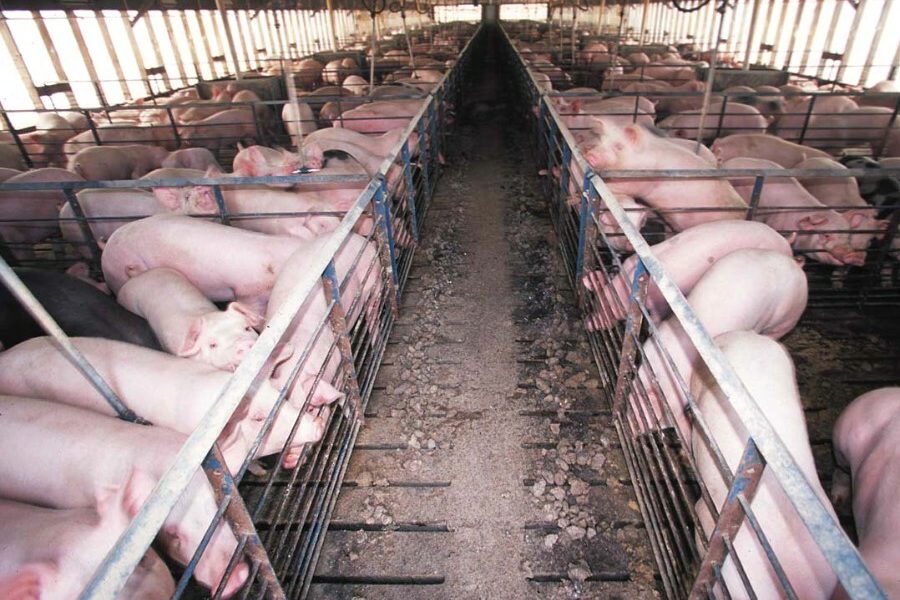Another Disease Outbreak Threatens U.S. Pigs, But Big Ag Would Rather Talk About Bacon Prices
Martha Rosenberg

Editor’s Note: This is a lightly edited version of an article that was originally published on the blog of the Organic Consumers Association. You can read the original article here.
There’s a lot the industrial factory farm industry prefers to keep consumers in the dark about, including what happens when millions of confined, stressed out animals with weakened immune systems are exposed to disease.
What’s the latest food animal pandemic Big Meat has been trying to keep out of the news? African swine fever (ASF), caused by the African swine fever virus (ASFV), a disease that just this year has killed one-fourth of the world’s pigs, including half of all China’s factory farm pigs.
So far, mainstream media’s coverage of ASF has focused almost exclusively on economic issues, including the disease’s potential impact on global trade. Questions about the pandemic disease potentials of intensive animal agriculture are skirted.
ASF originated in East Africa and reached Eastern Europe in 2007, where it has remained. Since ASF’s outbreak in China last year, in which half of the country’s pigs died and another 1 million were culled, ASF has spread to Vietnam, Cambodia, Laos, North Korea, the Philippines, more of eastern Europe and even Belgium.
“It’s not a question of whether ASF reaches American shores, but when,” write Thomas Parsons, professor at the School of Veterinary Medicine, and Scott Michael Moore, China Program Director at the University of Pennsylvania, in the Hill.
“Should the virus enter the U.S., your future as a pork producer would radically change,” warns Pork Business.
In acute cases, the ASF virus causes death in one to eight days. This allows the spread of the disease as animals and their meat are sold, either deliberately or not.
This is not the first time that Big Meat has kept the facts about major animal pandemics away from consumers, who likely would be turned off to industrially produced meat if they knew the truth. The factory farm meat industry also suppressed the facts about porcine epidemic diarrhea virus (PEDv) and avian flu.
By 2014, PEDv had killed 10 percent of pigs confined in factory farms in the U.S.
The PEDv scourge was so devastating, a Kentucky farm fed dead pigs to other pigs in an attempt to induce “immunity” in survivors.
To combat PEDv the government gave $11.1 million of our tax dollars to private farmers who were “producers of infected herds.”
Here’s a cheaper idea: How about giving the animals fresh air, space to move and no drugs?
From 2014 through mid-2015, 48 million chickens and turkeys were killed in the U.S. to prevent the spread of bird flu, and to protect farmer profits. Yet despite the mass murder spree, the disease resurfaced in 2017.
It’s easy to see why. To prevent the spread of bird flu, in many cases, healthy, floor-reared turkeys and broiler chickens were herded into enclosed areas where they were administered propylene glycol foam to suffocate them.
In other cases, birds were killed by “ventilation shutdown” – – the term used when barn temperatures are raised to at least 104°F for a minimum of three hours to kill the entire flock. As reported by Fortune, “round-the-clock incinerators and crews in hazmat suits” were commonly required for bird depopulation in 2015.
When farm animal disease pandemics hit in the U.S., Big Meat likes to control the mainstream media’s narrative by focusing the story on “the price of bacon,” trade wars or farmer profits. With the ASF virus, mainstream media is naively portraying it as a disease of other countries.
For example, The New York Times attributes China’s ASF to the country’s “emphasis on government-driven, top-down solutions to major problems, sometimes at the expense of the practical.” This analysis conveniently ignores the U.S.‘s recent PEDv and bird flu epidemics.
The Times also indicts China’s “small farms, often packed together in crowded agricultural areas,” for the pandemic — again conveniently ignoring the U.S.‘s own crowded factory farms, which are certainly at risk.
The real story of ASF is this: Factory farm animal prisons, with their pesticides, antibiotics and intense confinement, weaken the immune systems of animals, making them highly susceptible to pandemics. The model also causes egregious harm to workers, the environment and human consumers.
The African swine fever is just the latest example.




